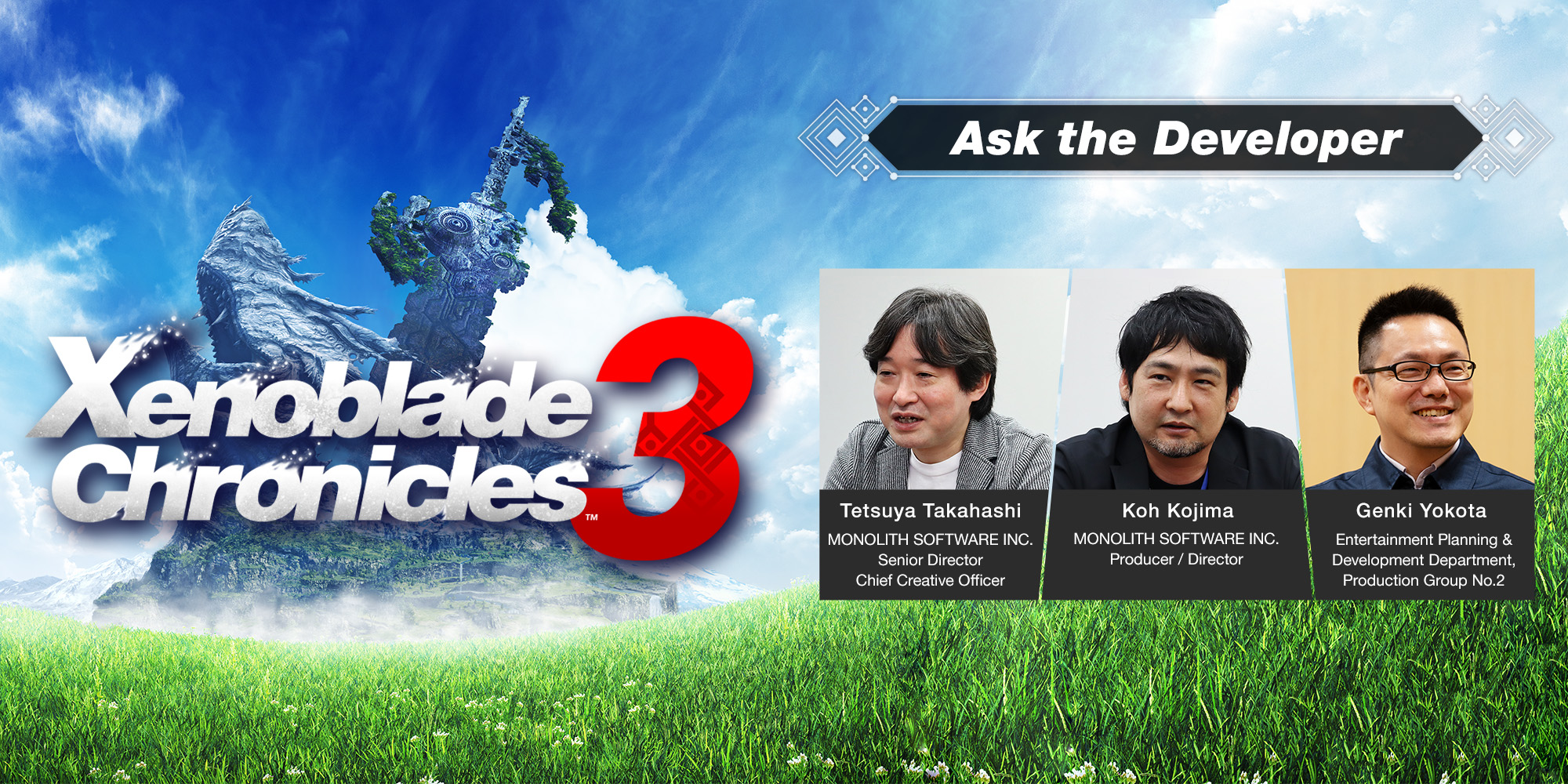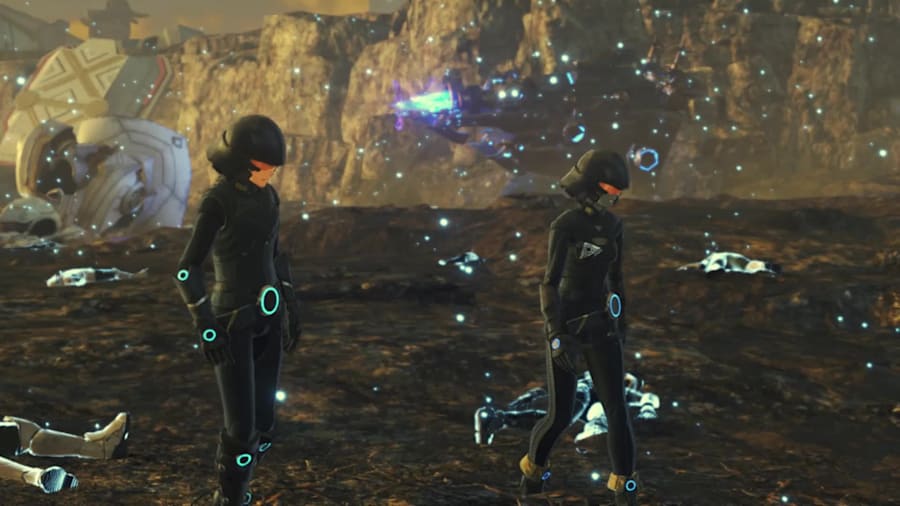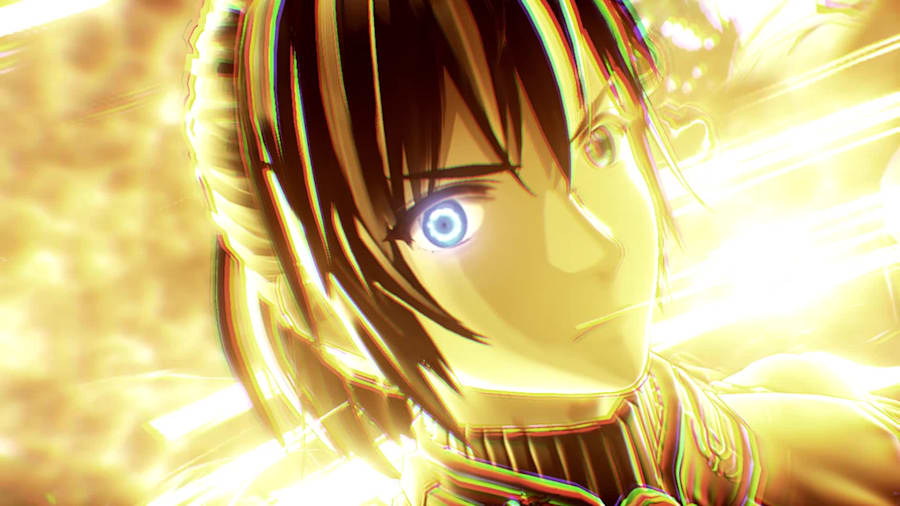Ask the Developer Vol. 6, Xenoblade Chronicles 3 – Chapter 1
26/07/2022

Content pre-recorded in accordance with current COVID-19 health and safety guidelines.
This article has been translated from the original Japanese content.
In this volume of Ask the Developer, an interview series in which Nintendo developers convey in their own words Nintendo's thoughts about creating products and the specific points they are particular about, we're talking to developers behind Xenoblade Chronicles 3, launching on Friday, July 29th.
Chapter 1: The relationship between "Xeno" (foreign) things
First, could we start off with a quick round of introductions?
Tetsuya Takahashi (referred to as Takahashi from this point on):
I’m Tetsuya Takahashi, senior director and chief creative officer at MONOLITHSOFT (1). As the executive director of the Xenoblade Chronicles series, I was involved in all aspects of the project for this title, including the initial planning and script writing, as well as supervising and directing a thousand other details.
(1) MONOLITH SOFTWARE INC. A game development company and subsidiary of Nintendo that works on the Xenoblade Chronicles series. It also developed the Xenosaga series released by NAMCO LTD. (currently Bandai Namco Entertainment Inc.) between 2002-2006.
Koh Kojima (referred to as Kojima from this point on):
I’m Kojima from MONOLITHSOFT. I was a producer and director for this game. At least that’s what my title says…
My main job was to coordinate between Nintendo and MONOLITHSOFT, and also between Takahashi-san and MONOLITHSOFT's development team.
Genki Yokota (referred to as Yokota from this point on):
I’m Yokota from Nintendo. My title was also producer and director, and as Nintendo’s lead, I worked on this game from the initial planning to completion. Simply put, I was the point of contact on Nintendo's side for discussing game content with MONOLITHSOFT. Thank you for having me today.

Thank you. We have MONOLITHSOFT, the developer of the Xenoblade Chronicles series, joining us remotely, and we hope to hear both Nintendo and MONOLITHSOFT’s thoughts on this title, as well as the stages of development and trial-and-error experiences behind the scenes.
Now then, Yokota-san, could you give us a brief introduction to the Xenoblade Chronicles series?
Yokota:
Of course. Developed by MONOLITHSOFT, Xenoblade Chronicles is a role-playing game (RPG) in which you can enjoy the characters and storyline created by Takahashi-san in a boundless, expansive environment. Rather than turn-based battles, you can enter battles seamlessly from the field with real-time control of the characters. It is a game you can play comfortably by making full use of timing and character positioning.
Thank you. So, this is the third entry in the series, but where does it stand within the series?
Takahashi:
This title is the third entry in the Xenoblade Chronicles series following Xenoblade Chronicles (2) and Xenoblade Chronicles 2, and is like the culmination of the trilogy.
The first entry depicts how the main character and his companions living in the world of Bionis, the god, utilise the future-seeing blade, the Monado, to protect the world they live in and fight for the future.
The second entry depicts a story of finite and eternal life, in which the main character, who lives in the world of Titans up in the skies, meets an immortal Blade girl, and they work together to reach paradise.
This third entry is a story about six young soldiers belonging to two hostile nations, set in Aionios, where the worlds of the first and second titles link together.
(2) Launched in August 2011 as a Wii exclusive game. A remastered Xenoblade Chronicles: Definitive Edition was launched in May 2020 for Nintendo Switch.
If the setting of this title is linked to the first and second entries, does that mean that the story continues through all three titles?
Takahashi:
No, the stories of one, two, and three all stand alone. Although some elements and designs from one and two will appear in this third entry here and there, there is no need to have played the first and second games to understand the story or how to play.
However, since this is a series of works, the underlying theme is consistent, and in each case, the story unfolds based on "the relationship between foreign things".
Also, I used the word "culmination" earlier, but this title brings together all the themes that have been developed over the past 15 years since 2007, when development of the first title in the Xenoblade Chronicles series began, as well as the gameplay systems that have been developed throughout the series.
Yokota:
So, by “culmination”, you don't mean that it brings closure to the series, but rather that it rounds out the trilogy thematically.
Takahashi:
Yes, that’s right. I guess you can say that this is like a summary for moving on to the next step in the future.
I see. Now, I would like to dig deeper into this title's story – the “culmination” of the series. How does the story for Xenoblade Chronicles 3 begin?
Takahashi:
This story's starting point is "unreasonable power”. The story itself begins on a battlefield. There are two hostile nations, and for the young people living there, the world is a place where fighting is a part of everyday life.
Then, young people from these two nations band together against this "unreasonable power" that forces them to fight on a daily basis. The story is about how they, with their inherently different ideas, cultures, and histories, will resist this great power.
So, to fight against the “unreasonable power”, the two opposing forces will fight together as one.
Takahashi:
Yes, that’s right. In creating my stories, I always try to portray the enemies in such a way that even a powerful enemy has their principles, justice, and righteousness so that we can partly sympathise with them. That is why I have always tried to cast the enemy in an ambiguous light, rather than making it clear whether they are good or bad.
By doing so, players can understand and immerse themselves in the enemy's perspective, and I think that is sometimes what makes the story interesting. But this time, I wanted to depict it from a different angle.
The reason is that I think "power" actually takes many forms, and that it is not about philosophy, justice, or righteousness, but more often, it is about something as simple as dignity or greed.

I see. So, it’s a battle against this unreasonableness that cannot be overcome by logic or rationality. Yokota-san, how did you feel when you first heard about this storyline?
Yokota:
Well, I wanted to know how this story would unfold as soon as possible, and I really wanted to move forward with development.
Already? At the proposal phase?
Yokota:
Yes. Having the first and second entries as the background, the proposal had the main protagonists divided between two rival nations, initially fighting each other, but then uniting... I thought, "The core theme is solid”.
Of course, there were challenges at the same time. (laughs)
Kojima:
Yes, I agree. At first, I thought it didn't feel like Xenoblade Chronicles at all... I think Takahashi-san was deliberately trying to remove the sense of "Xenoblade-ness" of the series.
The stories for the first and second games were completely different, but there was this "Xenoblade-ness" that was common to both of them. I didn't feel that at all at the initial proposal stage. And the reason for that is because this game's world is very serious.
That is the world that Takahashi-san wanted to depict in this title, but I was concerned about whether it would be acceptable to deliver it to players of previous games in the series, for what it is.
The design this time was also different from the previous games in the series. But after a lot of trial and error, we found a good balance, and in the end, I think we were able to create this "Xenoblade-ness."
Indeed, the story's introduction shows that people are born to fight, and with a lifespan of only 10 years...and I got a sense of the theme's seriousness. What was the reason for setting this 10-year life span?
Takahashi:
We humans have a life span of 70 to 80 years, and for some people, 90 years or more. But I have wondered how our perception of life would change if our lifetimes were shorter. So, if I simply set the life span to 10 years, I thought about which decade of life I should choose.
Looking back on my own experience, I think that the formative years for my personality were between the ages of around 0 to 10, but I also think that the most influential period for something like my outlook on life was between the ages of 10 and 20, the years when people are most impressionable.
It seems to me that, while they are both 10 years in length, it was a vulnerable period when I was exposed to many things, took on challenges, and created things as well, and my values and ways of thinking changed drastically. That is why I set the main characters to this period in their lives.
I see. So that’s why the soldiers from the two nations are all so young.
Takahashi:
I also wanted to convey to young generations nowadays, through my story, that they can create their own path however they want and that they should not give up on their dreams and goals.
Yokota:
We had a great deal of discussion in the beginning about why to have a 10-year life span. Although the seriousness was in full swing from the beginning, I remember hearing the thoughts Takahashi-san just mentioned, and I was in complete agreement.
Doing so would surely bring out that sense of Xenoblade-ness, and I thought that I wanted to stay the course with this storyline.

Takahashi:
The first title is kind of like a straight-A student for me. The second one is not quite a straight-A student, but it has a much brighter and more lighthearted start…
For the third title, I wanted to stop being a Goody Two-Shoes. It was a challenge when thinking about what kind of response I would get from people who had played the first and second titles, but one of this title's themes was "finding your new self and a new path toward the future", so I knew that I could not go back to the past or do the same thing again.
Kojima:
By listening to Takahashi-san's thoughts in detail, I decided to do my best to express what he wanted to convey.
This game starts with a battle scene, but the main character, Noah, is an “off-seer”, isn't he? I felt that this is also an unusual premise for a battle-focused game. What exactly is the role of an "off-seer"?
Takahashi:
Noah, the first main character that players can control, takes on the role of an "off-seer" who mourns the soldiers who have lost their lives on the battlefield. Through mourning, Noah thinks about a lot of things... As a character, I envisioned him like a philosopher.
A philosopher?
Takahashi:
If a person who has his own beliefs, who has a somewhat philosophical view of the world or life encounters various changes and events throughout the story and faces problems that cannot be resolved by his own logic, what kind of answer will this person find? In this way, I wanted to portray the character as a philosopher or a poet.
You mentioned earlier “the first main character that players can control”, but are there any other main characters?
Takahashi:
In this title, there are three characters from the nation of Keves, including the first playable character, Noah, and there are three from the nation of Agnus, including the heroine, Mio. The story unfolds with all six characters as the protagonists.
Noah is an off-seer from the army of Keves, and Mio is an off-seer from the army of Agnus. Although the two of them are the central figures among the six, all six are the game's main characters.
The game progresses with the premise that each of the six characters have their own thoughts towards their short 10-year life span, but for a single great purpose they will cooperate and set out on an adventure together.
Indeed, when I played the game, I got the impression that all six characters were moving the story forward.
Takahashi:
This time, I wanted to depict the feelings of the six main characters equally, so I tried to keep the word count of the dialogues as even as possible.
Of course, the central figures Noah and Mio have a few more lines, but compared to the first and second titles, which focused on the hero and heroine, you will notice that the other characters are also strongly involved in the story.
It may sound extreme, but I didn't want the other characters to just be nodding along toward the end of the game…
It certainly does feel awkward when the characters who have been on a journey together become less responsive midway through.
Takahashi:
Having more than one main character is something I have wanted to do for a long time. The main idea is similar to ensemble drama, a method of creating films or TV series, and I wanted to try to somehow incorporate this idea into a game.
Different lives, different positions, different points of view are interchanged to weave a single story.... In fact, this is very incompatible with RPGs. (Laughs)
In an RPG, the player projects themselves on to the main character, but it becomes difficult to follow the story if the player switches the viewpoint as they progress through the game. Also, the game requires all six characters to be in the same place at the same time, which was also an incompatible point.
I had to consider what kind of plot and setup I could use to make the story flow smoothly, while shifting between different points of view, as well as making it work as a game. Keeping these in mind, I implicitly incorporated it into the traditional game creation process.
It may be difficult for the players to notice, but personally, I feel that I was able to gain confidence in this method of game creation.
Yokota:
Also, in previous games in the series, the story progresses with six main characters, but only four of them took part in battles, so the number of playable characters displayed at any one time was limited. But this time, all six characters participate in battles, and this is what we were particular about for this title.
Since all six are the main characters this time, we decided that it would be an all-out battle, with all six being displayed at once.
Is there any particular reason for having six?
Takahashi:
It didn't necessarily have to be six. I would have been fine with four or eight playable characters. I settled on six main playable characters after considering the overall details, like the idea that four would feel too little and eight too many, as well as the limits of display, the limits in the volume of content we can create, and the ease of understanding when playing.
In fact, the second entry also has three pairs of two playable characters and displays six characters, but this time, the six playable characters fight independently. There is also a seventh character called a "Hero" who joins the fight. And multiple enemies are attacking as well.
One of the challenges we wanted to take on this time was to see how many players could be displayed at the same time while allowing the game to be played properly.
Speaking of pairs, one of the features of the new battle system is that two characters can Interlink.
Takahashi:
The Ouroboros system is implemented in this title as the symbolic form of "foreign things becoming one".
So, instead of two people piloting a robot or a vehicle, they fuse to become a single entity.
Yokota:
At the beginning of planning, there was an Ouroboros that looked like a robot, but it was not in a form that the characters would ride and pilot.
Kojima:
I think it was decided from the beginning that one consciousness would enter the consciousness of the other. I saw that Takahashi-san wanted to depict the kinds of things people can only understand about each other once they fully unite, an understanding that would otherwise need to be achieved via words or other means. And conversely, the kinds of common problems that become visible.
Takahashi:
This idea of "foreign things becoming one" is something we have been trying to express since the time of Xenogears (3) back in the day. A person's life is basically built up of relationships with other people. A relationship with foreign things. I’m always conscious of this perspective when I’m making things.
(3) Released in 1998 by SQUARE CO., LTD. (currently SQUARE ENIX CO., LTD.) for the PlayStation console. Tetsuya Takahashi directed and wrote the script.
Yokota:
"Xeno” in the title is an English prefix that means something like "foreign”, right?
Takahashi:
Yes it is. The relationship between “Xeno" (foreign) things is at the core of the series that bears this name.





